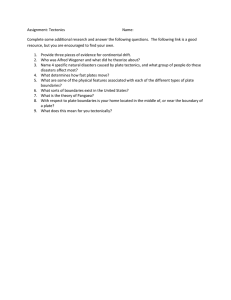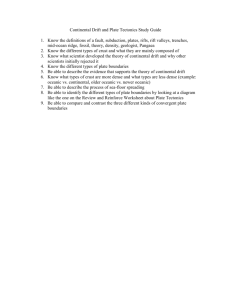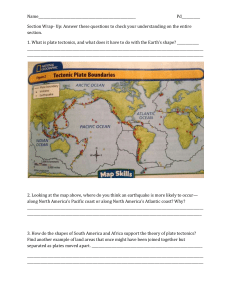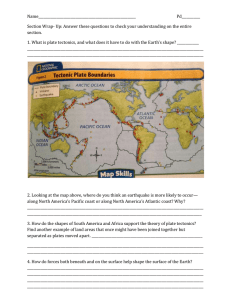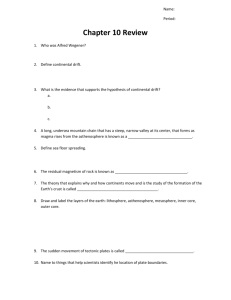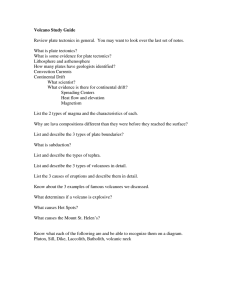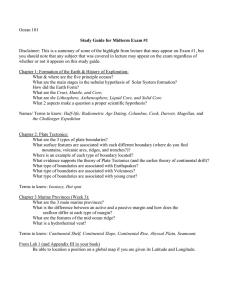Earth Science, 12e Plate Tectonics: A Scientific Theory Unfolds
advertisement
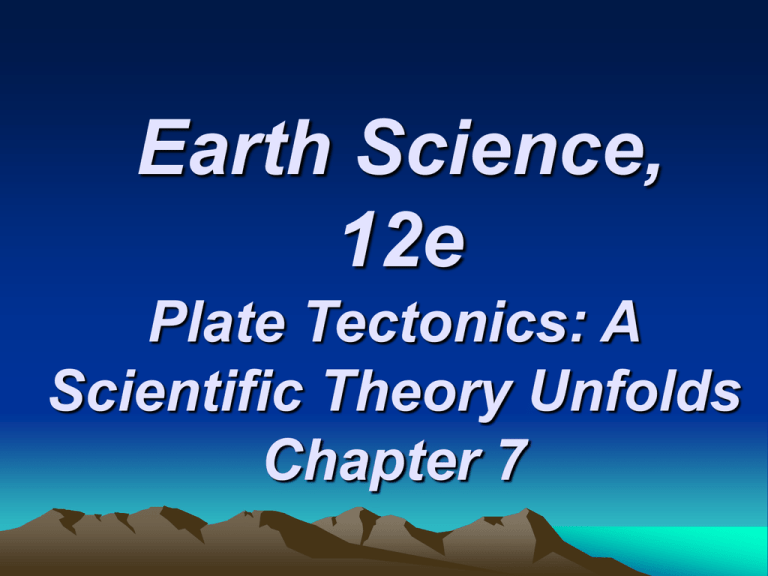
Earth Science, 12e Plate Tectonics: A Scientific Theory Unfolds Chapter 7 Continental drift: an idea before its time Alfred Wegener • First proposed hypothesis, 1915 • Published The Origin of Continents and Oceans Continental drift hypothesis • Supercontinent called Pangaea began breaking apart about 200 million years ago • Continents “drifted” to present positions • Continents “broke” through the ocean crust Pangaea approximately 200 million years ago Figure 7.2 Continental drift: an idea before its time Wegener’s continental drift hypothesis • Evidence used by Wegener • • • • Fit of South America and Africa Fossils match across the seas Rock types and structures match Ancient climates • Main objection to Wegener’s proposal was its inability to provide a mechanism Similar mountain ranges on different continents Figure 7.7 Paleoclimatic evidence for continental drift Figure 7.8 Plate tectonics: the new paradigm More encompassing than continental drift Associated with Earth’s rigid outer shell • Called the lithosphere • Consists of several plates • Plates are moving slowly • Largest plate is the Pacific plate • Plates are mostly beneath the ocean Plate tectonics: the new paradigm Asthenosphere • Exists beneath the lithosphere • Hotter and weaker than lithosphere • Allows for motion of lithosphere Plate boundaries • All major interactions among plates occur along their boundaries Plate tectonics: the new paradigm Plate boundaries • Types of plate boundaries • Divergent plate boundaries (constructive margins) • Two plates move apart • Mantle material upwells to create new seafloor • Ocean ridges and seafloor spreading • Oceanic ridges develop along welldeveloped boundaries • Along ridges, seafloor spreading creates new seafloor Divergent boundaries are located along oceanic ridges Figure 7.11 Plate tectonics: the new paradigm Plate boundaries • Types of plate boundaries • Divergent plate boundaries (constructive margins) • Continental rifts form at spreading centers within a continent • Convergent plate boundaries (destructive margins) • Plates collide, an ocean trench forms, and lithosphere is subducted into the mantle The East African rift – a divergent boundary on land Figure 7.13 Plate tectonics: the new paradigm Plate boundaries • Types of plate boundaries • Convergent plate boundaries (destructive margins) • Oceanic–continental convergence • Denser oceanic slab sinks into the asthenosphere • Pockets of magma develop and rise • Continental volcanic arc forms • Examples include the Andes, Cascades, and the Sierra Nevadan system An oceanic–continental convergent plate boundary Figure 7.15 A Plate tectonics: the new paradigm Plate boundaries • Types of plate boundaries • Convergent plate boundaries (destructive margins) • Oceanic–oceanic convergence • Two oceanic slabs converge and one descends beneath the other • Often forms volcanoes on the ocean floor • Volcanic island arc forms as volcanoes emerge from the sea • Examples include the Aleutian, Mariana, and Tonga islands An oceanic–oceanic convergent plate boundary Figure 7.15 B Plate tectonics: the new paradigm Plate boundaries • Types of plate boundaries • Convergent plate boundaries (destructive margins) • Continental–continental convergence • When subducting plates contain continental material, two continents collide • Can produce new mountain ranges such as the Himalayas The collision of India and Asia produced the Himalayas Figure 7.16 A The collision of India and Asia produced the Himalayas Figure 7.16 C A continental–continental convergent plate boundary Figure 7.15 C Plate tectonics: the new paradigm Plate boundaries • Types of plate boundaries • Transform fault boundaries • Plates slide past one another • No new crust is created or destroyed • Transform faults • Most join two segments of a mid-ocean ridge • Aid the movement of oceanic crustal material Testing the plate tectonics model Evidence from ocean drilling • Some of the most convincing evidence confirming seafloor spreading has come from drilling directly into ocean-floor sediment • Age of deepest sediments • Thickness of ocean-floor sediments verifies seafloor spreading Testing the plate tectonics model Hot spots and mantle plumes • Caused by rising plumes of mantle material • Volcanoes can form over them (Hawaiian Island chain) • Mantle plumes • Long-lived structures • Some originate at great depth, perhaps at the mantle–core boundary The Hawaiian Islands have formed over a hot spot Figure 7.21 Testing the plate tectonics model Evidence for the plate tectonics model • Paleomagnetism • Probably the most persuasive evidence • Ancient magnetism preserved in rocks • Paleomagnetic records show • Polar wandering (evidence that continents moved) • Earth’s magnetic field reversals • Recorded in rocks as they form at oceanic ridges Polar wandering paths for Eurasia and North America Figure 7.24 A Paleomagnetic reversals recorded by basalt flows Figure 7.27 Measuring plate motion Measuring plate motion • By using hot spot “tracks” like those of the Hawaiian Island–Emperor Seamount chain • Using space-age technology to directly measure the relative motion of plates • Very Long Baseline Interferometry (VLBI) • Global Positioning System (GPS) Directions and rates of plate motions Figure 7.28 What drives plate motion Driving mechanism of plate tectonics • No one model explains all facets of plate tectonics • Earth’s heat is the driving force • Several models have been proposed • Slab-pull and slab-push model • Descending oceanic crust pulls the plate • Elevated ridge system pushes the plate Several mechanisms contribute to plate motion Figure 7.29 What drives plate motion Several models have been proposed • Plate–mantle convection • Mantle plumes extend from mantle–core boundary and cause convection within the mantle • Models • Layering at 660 kilometers • Whole-mantle convection Layering at 660 km Figure 7.30 A Whole-mantle convection Figure 7.30 B Plate tectonics into the future Present-day motions have been extrapolated into the future some 50 million years • Areas west of the San Andreas Fault slide northward past the North American plate • Africa collides with Eurasia, closing the Mediterranean and initiating mountain building • Australia and new Guinea are on a collision course with Asia A possible view of the world 50 million years from now Figure 7.31
